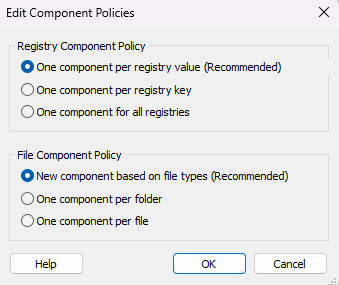
Customize Components' Rules & Preferences Through Admin Control Panel

Customize Components’ Rules & Preferences Through Admin Control Panel
Table of Contents
- Introduction
- Registration
- Using Advanced Installer
- GUI
- Working with Projects
- Installer Project
* Product Information
* Resources
* Package Definition
* Install Parameters
* Organization
* Search Pane
* Feature Properties
* Component Properties
* Edit Qualified Component And Group Dialog
* Edit Component Policies Dialog
* Feature Picker Dialog
* Builds
* Analytics
* SCCM
* ActiveSync
* Requirements
* User Interface
* System Changes
* Server
* Custom Behavior - Patch Project
- Merge Module Project
- Updates Configuration Project
- Windows Store App Project
- Modification Package Project
- Optional Package Project
- Windows Mobile CAB Projects
- Visual Studio Extension Project
- Software Installer Wizards - Advanced Installer
- Visual Studio integration
- Alternative to AdminStudio/Wise
- Replace Wise
- Migrating from Visual Studio Installer
- Keyboard Shortcuts
- Shell Integration
- Command Line
- Advanced Installer PowerShell Automation Interfaces
- Features and Functionality
- Tutorials
- Samples
- How-tos
- FAQs
- Windows Installer
- Deployment Technologies
- IT Pro
- MSIX
- Video Tutorials
- Advanced Installer Blog
- Table of Contents
Disclaimer: This post includes affiliate links
If you click on a link and make a purchase, I may receive a commission at no extra cost to you.
Edit Component Policies Dialog
In this dialog, you can change the Component Policy for files and registry entries.

Registry Component Policy
In this section you can configure the Component policy for the Registry.
One component per registry value (Recommended)
Check this option to create a component for each registry value that is created.
One component per registry key
If this option is checked, for registry keys with multiple registry values only a component will be created.
One component for all Registries
This option will ensure that a single component will be created for all registries so if there are multiple keys and values, all of them will be in the same component. This option is useful for minimizing the installation time in scenarios with a large number of registers .
File Component Policy
This section allows you to set the Component policy for the Files
New component based on file types (Recommended)
if this option is checked, a new component may be created or an already existing one will be used based on the type of the files.
One component per folder
This option will ensure that only one component will be created for all the files contained by a folder, disregarding their type.
One component per file
This option will create a new component for each file, disregarding its type.
Did you find this page useful?
Please give it a rating:
Thanks!
Report a problem on this page
Information is incorrect or missing
Information is unclear or confusing
Something else
Can you tell us what’s wrong?
Send message
Also read:
- [New] The Future Speaks Inspirational Metaverse Quotes with AR/VR for 2024
- [Updated] 2024 Approved Step-by-Step Webcam Recording on HP Systems
- 2018 IBM/Ponemon Institute Report: Analyzing the Financial Impact of Data Security Incidents on Companies
- Boost Directive Perfection Using These Innovative Online Helpers
- Clubhouse App: The Ultimate Guide to Accessing It From Your Desktop
- Craft Your Dream House with Expert Custom Builder Services
- Expert-Level Installation Suite
- How to Speed Up Your Sluggish Chrome in Minutes
- Identifying Signs of Mobile Internet Throttling: What You Need to Know
- In 2024, 3 Ways to Export Contacts from Apple iPhone 13 Pro to Excel CSV & vCard Easily | Dr.fone
- Unlock OnePlus Ace 3 Phone Password Without Factory Reset Full Guide Here
- Title: Customize Components' Rules & Preferences Through Admin Control Panel
- Author: Stephen
- Created at : 2024-10-08 05:49:26
- Updated at : 2024-10-10 20:50:59
- Link: https://fox-place.techidaily.com/customize-components-rules-and-preferences-through-admin-control-panel/
- License: This work is licensed under CC BY-NC-SA 4.0.